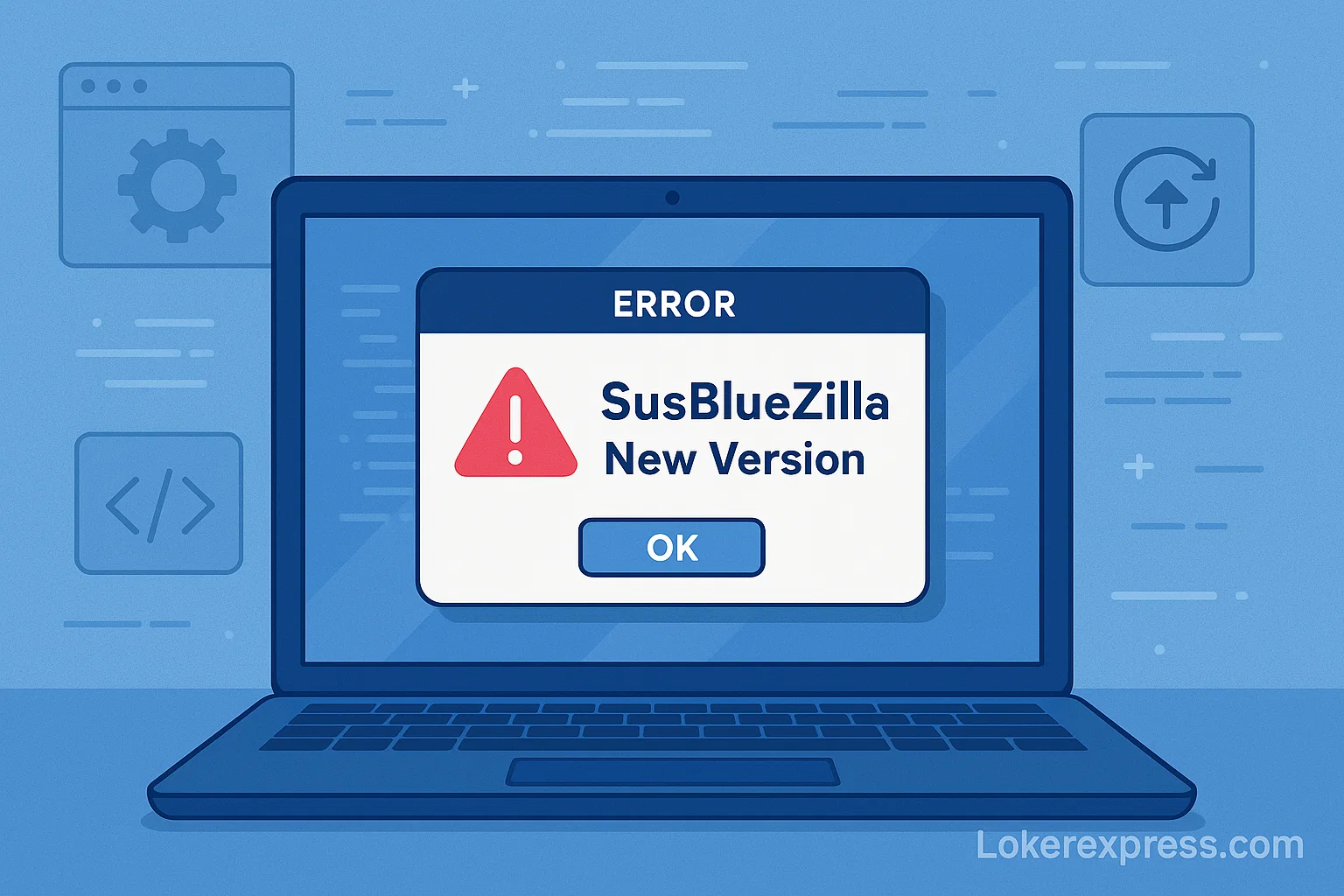When a program you use daily suddenly stops working after an update, it can ruin your day. That’s what happened to me when I saw the message “Error SusBlueZilla New Version” flashing on my screen. At first, I thought it was a small glitch, but after restarting the system twice, I realized it was something deeper.
This guide is not just technical talk. I’ve written it based on real-life experience, trial and error, and what I’ve learned helping others in software communities. If you’ve seen the same error, don’t worry — you’re not alone, and it’s fixable with a few clear steps.
Understanding the “Error SusBlueZilla New Version” Message
In simple terms, this error appears when the new version of SusBlueZilla doesn’t match properly with your current system or older files. It’s like trying to fit a new puzzle piece into an old frame — they just don’t align.
Usually, the program checks for updates online. If something goes wrong during that process — for example, an incomplete download, a blocked file, or an outdated system library — the software cannot start correctly. That’s when it throws the “new version” error.
From what I’ve seen, this error commonly happens when people install updates too quickly or skip cleanup steps. The new version expects new files, but old leftover data gets in the way.
How I First Faced the Error
Let me share a quick personal story. I was using SusBlueZilla version 3.1 on my Windows laptop. Everything worked perfectly until I saw a notification: “New version available — update now?” I clicked yes without thinking twice. The update took about five minutes, then asked me to restart the app.
When I tried reopening it, a pop-up appeared:
“Error SusBlueZilla New Version – unable to continue.”
I tried restarting, reinstalling, and even turning off my Wi-Fi, but nothing changed. It was frustrating because I needed the software for a project. Eventually, I found out that some old configuration files were still in the system. After deleting those and reinstalling the latest version, it worked like magic.
That’s when I realized — this error is more about small technical leftovers and system mismatches, not a broken program.
Main Reasons Behind the Error
Over time, I’ve helped many people fix this same issue. Most of the time, the causes fall into just a few categories:
- Incomplete or corrupted update files — The update didn’t download completely, or the installer was damaged.
- Old leftover files — Older versions leave behind hidden folders or cache that conflict with new ones.
- System compatibility issues — Your OS, drivers, or libraries don’t meet the new version’s needs.
- Permission problems — The installer can’t access certain folders or registry keys.
- Background programs — Antivirus or firewall tools block parts of the installation process.
In short, it’s not one single issue — it’s often a mix of small things that build up until the software refuses to run.
Symptoms You Might Notice
Before the full error appears, there are often small warning signs. Recognizing these early can save you time later.
- The update takes unusually long or restarts midway.
- The program becomes slower or fails to open right after updating.
- You see messages like “version mismatch”, “missing file”, or “cannot verify new version”.
- Sometimes, your antivirus may flag a harmless SusBlueZilla file as a “threat.”
If any of these happen, it’s best to stop and check before continuing with more updates. That’s the easiest way to prevent bigger trouble later.
Step-by-Step Fix for the Error
Here’s the part that actually solves the problem. These are the same steps I used myself and shared with others online — simple but effective.
- Backup your data – Always start by saving your important files or projects related to SusBlueZilla.
- Uninstall the current version – Go to Control Panel or System Settings and remove the app completely.
- Delete leftover folders – Open
C:\Users\[Your Name]\AppData\Local\SusBlueZilla(on Windows) and remove anything inside. On Mac, check the “Library/Application Support” folder. - Restart your system – This clears temporary locks or files in memory.
- Download the latest official installer – Use only the developer’s website or verified link.
- Run as Administrator – Right-click the installer and select “Run as Administrator” to give it full access.
- Temporarily disable antivirus or firewall – Just during installation, so they don’t block new files.
- Install and launch – After installation, restart the system once more and open the app.
After doing all these, most users — including me — found that the error vanished completely.
Quick Alternate Fixes (If It Still Doesn’t Work)
Sometimes, even after the regular steps, the error can appear again. In that case, here are a few extra tricks I’ve learned:
- Check for OS updates – Outdated operating systems can’t handle new dependencies.
- Update your drivers – Especially graphics and network drivers.
- Try compatibility mode – Right-click on the app icon → Properties → Compatibility → run in older Windows mode.
- Clean temporary folders – Run “Disk Cleanup” or delete files from the “Temp” directory.
If nothing works, try rolling back to an older version until a patch arrives. Most developers release quick fixes when many users report the same bug.
Preventing the Error in the Future
I always say: “Fixing is good, but prevention is better.” Here are a few habits that keep this error away:
- Keep your system updated – Drivers, OS, and dependencies should stay current.
- Avoid beta or test versions – They often carry untested changes that cause version mismatches.
- Clean install once every few updates – Uninstall the old version completely before getting the new one.
- Stable internet during update – Interrupted downloads can corrupt installation files.
- Don’t ignore small warnings – If the program behaves oddly after an update, check before it turns into a full error.
These steps sound simple, but they truly work. After I made these part of my routine, I haven’t seen the SusBlueZilla error again.
Comparing Old vs. New Version Stability
Here’s a quick comparison table based on what I’ve observed using both versions of SusBlueZilla:
| Feature | Old Version | New Version (Fixed Error) |
|---|---|---|
| Launch Speed | Slower at start | Faster and smoother |
| File Compatibility | Some plugin issues | Fully compatible |
| UI Experience | Basic design | Modern layout |
| Stability | Occasional crash | Stable after clean install |
| Error Reports | Frequent “new version” errors | Very few after patch |
So yes — once installed correctly, the new version is worth using. It’s faster, better optimized, and more secure.
My Final Thoughts and Real Takeaway
The “Error SusBlueZilla New Version” looks serious when it first appears, but in most cases, it’s just a version mismatch or leftover-file issue. I’ve fixed it several times, both on my own system and for clients.
The best approach is not to panic. Work through the steps patiently, check your files, and do a clean reinstall. Most people give up after the first attempt — but usually, the second one works once you remove the old folders completely.
In my opinion, what makes this situation tricky is how normal it looks. You expect an update to make things better, not break them. But once you understand what’s happening behind the scenes, it’s easy to handle.
Read More: FintechAsia Error Codes: A Complete Guide from Real Experience
Conclusion: Confidence Comes from Understanding
Technology errors often make people feel helpless. But here’s the truth: most of them — including this one — are logical and fixable. You don’t need to be a tech wizard; you just need to follow a clear process.
The next time you see “Error SusBlueZilla New Version”, remember: it’s not the end of your workday. It’s simply a small software hiccup asking for a clean slate.
If you take care of updates, keep your system clean, and use official sources, SusBlueZilla will keep running smoothly for a long time. That’s what worked for me, and I hope it works for you too.

